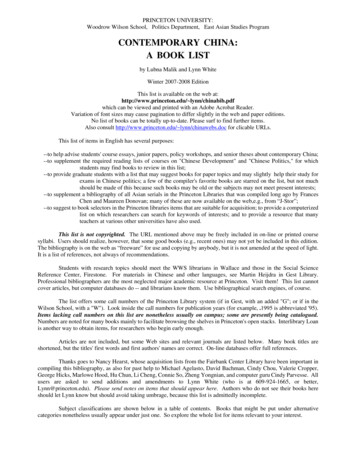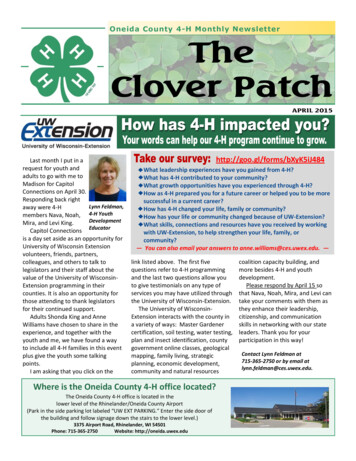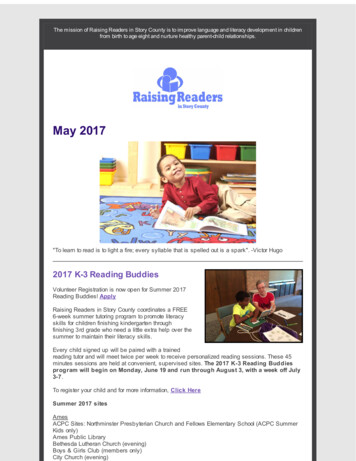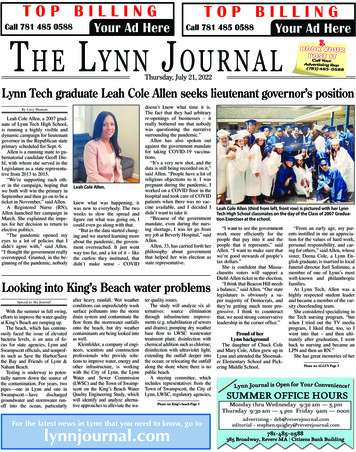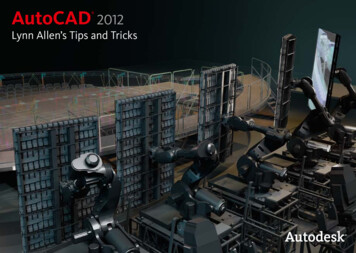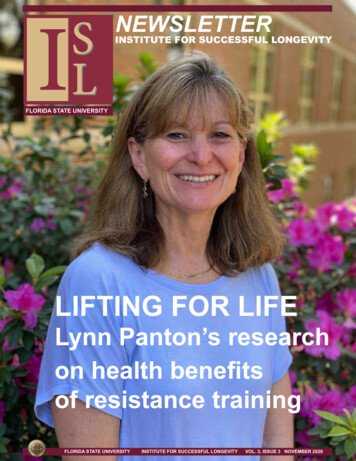
Transcription
NEWSLETTERINSTITUTE FOR SUCCESSFUL LONGEVITYFLORIDA STATE UNIVERSITYLIFTING FOR LIFELynn Panton’s researchon health benefitsof resistance trainingFLORIDA STATE UNIVERSITYINSTITUTE FOR SUCCESSFUL LONGEVITYVOL. 3, ISSUE 3 NOVEMBER 2020
Smartphones and the futureof remote health monitoringIn a recently published chapter in a book by the National Academies Press,we (Neil Charness, Walter R. Boot, Nicholas Gray) examined the state of whatwe called “MMI” (“emmy”): Mobile Monitoring and Intervention technology.We were referring to devices that can monitor aspects of your current status,make predictions about your future status, and, potentially, provide efficaciousinterventions to improve your quality of life as you age. Most of the research thathas been done so far in this arena has used the ever-popular smartphone.Smartphones today are loaded with a wide variety of sensors that can provideinformation about your position in space (using GPS, A-GPS, barometer), howfast and what direction you are moving (accelerometer, gyroscope), lighting levels,sound levels (and potentially, what you are listening to), what you are looking ator how you look (via cameras on the front and rear of your smartphone), howclose your smartphone is to you (proximity sensor), and when you interact withprograms on the phone, information about program use, etc.FROM THE DIRECTORNeil Charness, Ph.D., is theWilliam G. Chase Professorof Psychology at FloridaState University and directorof the Institute for SuccessfulLongevity.That stream of information can enable artificial intelligence (AI) programs on thephone, or in the “cloud” (when you phone is connected to the Internet) to drawinferences about your state of mind or state of health. For instance, AI programscould serve as “mood detectors,” inferring that you are ill or depressed becauseyou spent the entire day in your room and never phoned or texted the people youusually interact with. They could verify this inference by sending you a probe that asks you to rate your mood. Theoretically,but not yet happening, an AI program could target you help to counteract depression or suicide risk, using just-in-timeinterventions.Similarly, another mobile device growing in popularity is the smartwatch. These devices are continually adding new sensorcapabilities so that the watch can monitor skin temperature, skin conductivity, color changes in skin that indicate heart rateINSTITUTE FOR SUCCESSFUL LONGEVITYNEWSLETTER NOVEMBER 2020Page 2
(blood flow patterns), blood oxygen levels, body motion, and location. AI programs in the cloud (and increasingly on thewatch) can gauge how well you are sleeping, determine if you are staying still or moving, assess what type of exercise you areengaged in (e.g., running, biking), can infer that you have just fallen. By combining knowledge of the world and sensor data,even more subtle inferences are possible, such as when you are typing on a computer keyboard and what you are typing.Thus, in the not so distant future, your mobile devices (or fixed sensors in your home), could monitor your health and wellbeing on a moment to moment basis offering advice about how to stay in better physical and mental health or alerting othersif you suddenly become incapacitated. For some, this monitoring may be a welcome prospect, such as for worried childrenof aging parents. To others, this monitoring could be seen as Big Brother invading your privacy.The key is to safeguard privacy and confidentiality of the data stream from your devices. At the moment, all your data arefair game for the device manufacturer or app designer, who typically requires you to consent to data transfer as part of theprivilege for using their devices and apps. Your smartphone service provider is also monitoring your location to connectyou to the best cell tower or hand you off when you are driving to the next one. Similarly, the government mandates thatyour phone call and text information be retained in case law enforcement convinces a judge that they need to consult thoserecords to solve a crime.The New York Times looked at the extent of tracking of cell phone data in a recent set of stories showing how it was easy todetermine what someone was doing based solely on location information over the day.So, there are positives and negatives to MMI technology. We will need to convince our legislators to strike the right balancebetween personal needs (for data privacy, security), and societal needs (for public safety). Then this technology mayrightfully win an MMI award. Best picture of health for successful longevity?Want to use the Zoom video platform?ISL’s Zoom guides show you howTo assist older adults who are not familiar with the Zoom video platform, the Institute for Successful Longevity offersillustrated how-to documents that take you through the steps of creating a Zoom account, joining a Zoom meeting, andscheduling meetings of your own.“Research studies suggest that about a quarter of the U.S. older adult population suffers from loneliness, and we areconcerned that this could become more widespread under the social distancing required to prevent spread of the COVID-19virus,” said Neil Charness, director of the institute.“ISL’s research has shown that older adults can use technology to combat social isolation,” Charness said, “so we developedour Zoom guides to help people use their computers to connect with others.”The how-to guides are free to the public and can be viewed and downloaded here via these links. They cover: How to create your Zoom account. How to join a Zoom meeting. How to schedule a Zoom meeting.The institute also has recruiting tech-savvy older adults who can assist others who have questions about the Zoom platform.If you would like to talk to one of ISL’s Zoom mentors, send an email to ISL@fsu.edu.For more information, visit isl.fsu.edu.INSTITUTE FOR SUCCESSFUL LONGEVITYNEWSLETTER NOVEMBER 2020Page 3
Lifting for life — ISL Faculty Affiliate Lynn Pantontalks about the benefits of resistance trainingDr. Lynn Panton, a Faculty Affiliate ofthe Institute for Successful Longevity, is aprofessor in the Department of Nutrition,Food and Exercise Sciences and a Fellow ofthe American College of Sports Medicine.Her research focuses on strength training andits effects on body composition, strength andfunctional outcomes of healthy older adultsand chronically diseased populations. Herrecent research has focused on the effects ofstrength training in women breast cancersurvivors.We spoke with her about the benefits ofstrength/resistance training — weight work —for older adults.Strength training is important,particularly for older individuals, butwe do not see a lot of older individualsdoing strength training in the healthclubs.I think a lot of older adults, especially inhealth clubs, are very intimidated by theweights and are intimidated by the peoplewho are using the weights, especially olderwomen. So, the weight room, is not always anarea where many older adults will frequentlyvisit. However, things are getting better.Lynn Panton did her BS in Psychology at Emory University andSome health clubs have special areas forearned her master’s degree and doctorate in Exercise Physiologyolder adults and for individuals who may be at the University of Florida.intimidated by the traditional free-weightroom. There are also programs at YMCAs,senior centers, and retirement facilities that will have strength training programs for older adults and have instructors thatare knowledgeable about strength training for individuals who are older or who may have underlying diseases.If I walk and swim and am very physically active, why do I need to do strength training?Activities like walking, swimming, cycling and dancing are very important for improving our aerobic fitness levels andhelping to prevent cardiovascular diseases, strokes, type 2 diabetes, cognitive decline, and different types of cancer, forexample. However, these activities do not help us increase or maintain muscular strength, muscle mass, and bone mineraldensity. Do you know that muscle mass and bone mineral density start declining in our late 20s and early 30s if we are notdoing activities that promote muscle and bone health like strength training? For women, this is even more crucial, sinceonce we hit menopause it is very difficult to maintain bone mineral density without estrogen. Women can lose 1-2% of theirbone each year. Men also lose bone mineral density, but they have a greater mass to begin with, so it takes a little longerINSTITUTE FOR SUCCESSFUL LONGEVITYNEWSLETTER NOVEMBER 2020Page 4
before their bone levels drop to levels where they become osteopenic (border-line low) or osteoporetic (low bone levels).Higher-impact activities like running or jogging do help to improve or maintain lower-body bone mineral density in thehips and the legs but do not help the bone in the upper body. High-impact activities like running are also very difficult todo for individuals who suffer from joint problems in their knees and hips. Therefore, strength training is a safer and moresustainable option for improving bone density in the lower body in addition to the upper body.Our research and research of others with women who are breast-cancer survivors really illustrate the importance and needfor cancer survivors to be doing strength training. Cancer treatments such as chemotherapy, hormonal suppressant therapyand radiation can directly affect muscle and bone cells. We have found breast cancer survivors to have lower strength,physical function, muscle mass, and bone mineral density compared to age-matched women who have not been treated forProfessor Panton and herresearch team, all doctoralstudents in FSU’s Departmentof Nutrition, Food and ExerciseSciences, from left: ChristopherSchattinger, Taylor Behl, Panton,and Matthew “Jake” Martenson.cancer. Women who have had to have their breast tissue removed are told not to lift objects of more than 10 pounds untiltheir surgery sites have healed. What is unfortunate is that many times they are not encouraged to strengthen that area onceit has healed. So upper-body strength, muscle mass, and bone density are low, especially in the affected arm next to thebreast that was removed. Strength training is so beneficial for women in helping to improve strength and physical function,increase muscle mass, and maintain bone density.Other than improving bone density, and that is a really good reason, are there other reasons to dostrength training to build up muscle mass?Strength training is so important for all of us, young and old. Although physical function may not be a problem for youngerindividuals, as we get older doing our activities of daily living can become more challenging. Strength training has beenshown to improve physical function such as doing your groceries, carrying your grandchildren, doing household chores,mowing the lawn, opening that jar of pickles, and improving your tee shots. Strength training also helps to prevent injuries.We cannot prevent accidents — we all have accidents. I have accidents, I fall down the stairs, trip over things while walking,and I have been hit from behind while driving. We cannot always prevent those things from happening. But what we can dois build up our physical reserve and make sure we have the strength in our muscles, connective tissue, and bone to prevent aserious injury. Strength training is a way to do that.INSTITUTE FOR SUCCESSFUL LONGEVITYNEWSLETTER NOVEMBER 2020Page 5
When you say strength training, what do youmean?Resistance or strength training is made up of exercisesthat are going to overload the muscles. We recommenda weight or resistance that causes fatigue to the muscleswithin eight to 12 repetitions for younger adults and 10 to15 repetitions for older adults. You should be able to do therepetitions at least eight times; if you cannot complete eightrepetitions, the weight is too heavy. If you can get to 12 or15 repetitions before fatiguing, you need to increase theweight you are using.Are you ever too old to strength train?You are definitely never too old or have been sedentarytoo long to start a strength training program. Studies haveshown individuals into their 90s and past 100 still retainthe ability in their muscles to get bigger and stronger. It isnever too late.Do you have to go to a gym?.No, you do not have to go to a gym. You can strength trainat home. You also do not have to go out and buy a lot offancy weights or machines. You can use things around yourhome like milk jugs that have handles. You can fill the jugswith a little bit of water or a lot, and you can put sand orpebbles in the jugs to make them heavier. You can get oldtube socks and fill them with sand to make ankle weights.There are several websites that can give you ideas on howto make ankle weights at home. You can use dumbbells,soup cans, sandbags, a broom stick with weighted bags onthe ends, anything that you can lift that will overload yourmuscles will work.If older adults were to just get started, what couldthey do? What do you recommend?Join Lynn Panton’s talk Dec. 7 via ZoomYou are invited to hear Lynn Panton, Ph.D., talk on“Strength Training — The Fountain of Youth?” at the nextInstitute for Successful Longevity Brown Bag at 2 p.m.December 7.This semester, all of ISL’s Brown Bags are conducted viaZoom.If you would like to join Dr. Panton’s Brown Bag talk,please send an email to ISL@fsu.edu and request the link.If you have never used Zoom, ISL has free how-to guidesthat show you how to set up a Zoom account and join ameeting. You can read or download our Zoom guides ell, there’s a number of resources. One of the free resources, tax dollars at work, is the booklet “Go4Life,” produced by theNational Institutes of Health through the National Institute on Aging (available as a PDF at -04/nia-exercise-guide.pdf). It has a section on strength training. It is a good place to start.I have also helped write a book with one of my graduate students and Dr. Alice Pomidor in the FSU College of Medicine,“Exercise for Older Adults,” which talks about different activities and has a chapter on strength training for a home-basedexercise program. You can download the PDF of the book from our College’s website on my webpage under teachingresources at ise-sciences/faculty-staff/panton/. There is also a linkthere to the NIH website where you can get their exercise materials. A great place to start exercising is at home so you canget comfortable with the different exercises. If you get bored with the home exercises, the resistance machines at a localfacility are also ideal. They can provide a greater stimulus for strength benefits. If there is an exercise facility where you feelcomfortable attending, I highly recommend doing those types of exercise machines.INSTITUTE FOR SUCCESSFUL LONGEVITYNEWSLETTER NOVEMBER 2020Page 6
Longevity expert George Rebok of Johns Hopkinsto speak on cognitive training on December 3You are invited to join Professor George Rebok, Ph.D., M.A., of Johns Hopkins University for his talk on “PreventingCognitive Decline and Alzheimer’s Dementia: The Evidence for Cognitive Training.”Rebok’s address, at 3:30 p.m. December 3, is part of the Institute for Successful Longevity’s Speaker Series. Each fall andspring semester, the institute brings in an expert on aging to talk about their work and to discuss trends in longevity research.Rebok’s address will be virtual, via the Zoom platform. For a link to the Zoom event, please send an email to ISL@fsu.edu.If you have never used Zoom, the Institute for SuccessfulLongevity has put together guides that show you how toset up a Zoom account and join a meeting. You can reador download the Zoom guides at ISL Zoom Guides.Since joining the Johns Hopkins University faculty in1989, Rebok has pursued research in two interrelatedareas: 1) the design and implementation of preventivetrials targeted at childhood antecedents of adolescentand adult psychopathology, including depression, earlyachievement problems, and poor concentration, and2) the neurocognitive predictors of functional abilitiesand decline in demented and nondemented older adultsand their modifiability through interactive cognitiveinterventions. His two research streams converge arounda common focus on attentional and cognitive parametersof maladaptive behavior, plasticity of functioning,perceived competence or self-efficacy as a variablelinking physiological, psychological, and social function,and short- and long-term outcomes of preventiveintervention and treatment.We spoke with Professor Rebok about his upcomingaddress.George Rebok, Ph.D. — My presentation is goingto focus on preventing cognitive decline and reducingdementia risk. And I’m going to be examining theevidence for and against cognitive training. I thinkthere is still a lot of controversy about whether cognitivetraining works, and, if it works, for whom does it workbest? And so I’m going to try to take a critical look atthat evidence.There’s been a wide kind of spectrum of opinion on this topic, from people who just kind of reject the evidence and say, youknow, this is all just to make money, there’s no really hard evidence to support this training . I think the evidence is verypromising. We are still in relatively very early days of cognitive training. And we certainly need better quality, more rigorousresearch, and I’m going to certainly make a plea for that. I think the other thing that I would really stress, though, is thatINSTITUTE FOR SUCCESSFUL LONGEVITYNEWSLETTER NOVEMBER 2020Page 7
cognitive training can’t exist in isolation, in terms of being the means to improve people’s cognitive health. There are manymore approaches these days that use cognitive training in conjunction with other things like lifestyle changes, increasingpeople’s social connections, reducing their blood pressure and health management. So, I think, you can’t just look atcognitive training in isolation. You know, it’s part of a whole program of good health practice.Another issue that’s really important is that we can design cognitive training programs, and there are dozens, dozens ofprograms out there, but nobody uses them. We’re only using them for a little bit, and then they become bored. That doesn’tdo anybody any good. So I think one of the big questions we’re facing in this field is how do we get people to adhere to thecognitive training programs and build it into their lives in a seamless way? How do you build that into people’s routines sothat they don’t think of it as just a one-off type of activity?In my talk, I’ll introduce some novel approaches that go beyond cognitive training that have been very promising and thatmight be part of the future directions that we take.I hope I get a lot of questions from people who are skeptics, because I think we have to be very critical in this area.Some skepticism comes from the advertising of commercial products that were promising an awful lotout of playing games.There is a lot of confusion in the public’s mind, as well as people in the field, the research field, about what training reallyis. Lumosity and these other popular programs that are heavily advertised, they promise great things — they’re going tomake you smarter, and they’re going to prevent dementia, they’re going to make you more popular, whatever it is. And,you know, a lot of those claims just aren’t substantiated. A lot of those programs have very little if any scientific evidenceto back them up. This stimulates a general skepticism. I never use the term brain training in my own work, and I know alot of other serious researchers don’t like that term, because we’re not really changing or training the brain, per se. And thebrain-training programs developed for commercial purposes, they’re not really concerned with whether the training has anyimpact on what you do day to day. What they have often are a lot of little puzzles and games that are kind of interesting, thatare meant to get you coming back and paying for the training, but that are not really systematically related to the real life,important activities people do.When you look at the cognitive-training research done by scientific investigators, that’s very different from these braintraining programs. I mean, that research typically has a very strong theoretical basis. It has a structured sequence, series ofexercises, and has been very carefully thought out, and unlike a lot of these brain-training programs there’s often an explicitattempt to build in the everyday relevance of what you’re learning and how you connect that with your everyday life. Andthey are evaluating the efficacy of that training, not only what the training does immediately after you’ve done the trainingbut also what the long-term benefits are.A lot of these programs have shown very, very good evidence that this training works. The effects aren’t always dramatic, butthey don’t really have to be dramatic to make a difference in people’s lives, and the effects do last for a long time, in manycases up to 10 years. And in some studies there’s evidence that the training does generalize or pertained to what you do dayto day.This must be a very exciting field for research. Every American of a certain age has a concern aboutmental abilities.Yes, it’s really a very exciting and vibrant area. There have been national surveys done by AARP and other organizations thatshow that concern about memory loss and dementia is the top or near top concern for many older people. I’ve been in thefield for several decades, and at the beginning of my career nobody, nobody was paying attention. It just wasn’t on the radaryet. And it’s only been because of more national recognition of the increase in projected increases in Alzheimer’s disease,and what a problem this is a public-health problem that people have turned to, you know, different ways we can help solve it.I think cognitive training is part of that solution, not the only thing, but part of the solution.INSTITUTE FOR SUCCESSFUL LONGEVITYNEWSLETTER NOVEMBER 2020Page 8
If you would like to talk to one of ISL's Zoom mentors, send an email to ISL@fsu.edu. For more information, visit isl.fsu.edu. 22 Page 4 Lifting for life — ISL Faculty Affiliate Lynn Panton . the American College of Sports Medicine. Her research focuses on strength training and its effects on body composition, strength and





